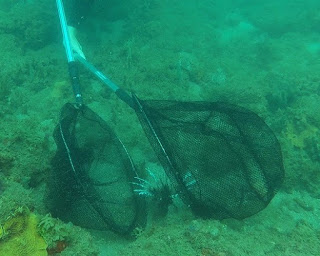 |
| The prettiest pest I've ever seen |
Probably one of the biggest projects ongoing on the marine
sites in Honduras is the lionfish project. The lionfish is an invasive species
in the Caribbean, originating from the Indo-Pacific, and most likely introduced
here as a pet that got too big and greedy for a home aquarium. Their numbers
have exploded, and they have now been found everywhere from north of Florida to
the east coast of Brazil. Even the Mediterranean has been invaded, although how
the lionfish got there is likely a whole different story. The Pez de Leon, as
it is known in Spanish, is causing havoc wherever it goes with its sharp venomous
spines that make it an unappealing snack for most predators. I mean, if you can
choose between biting into a fluffy muffin or a cactus, I know which one I’d go
for. To add to its fine qualities as an invader, a lionfish is not too picky
about its own diet, eating pretty much anything bitesized and unlucky to be
around when their stomachs grumble – little brother might want to stay a safe
distance away! With no predators specialized in hunting them and by eating
anything that comes their way, the lionfish are causing drastic changes in
Caribbean reef dynamics.
 |
| Capturing lionfish is tricky business, but not because they are fast. |
The projects here concentrate a lot around lionfish behaviour. There are projects that are undertaken in the lab, where a lionfish is provided a choice between a chemical cue, where another lionfish is put in a blackened bucket with small holes in it below water level, and a visual cue, where a see through, non-holey bucket is a temporary home to another lionfish. The test object is then given 30 minutes to choose whether it would like to hang out with the one it can smell, or the one it can see, and the trials are recorded with a GoPro. Why? Because currently the only method used for trying to reduce the numbers of lionfish is culling. If the lionfish were only hanging out up to 30 meters down from the surface that would be fine, but unfortunately they are known to have massive populations living in as deep as 300 meters. The few that we can see during our snorkels and dives are probably just the rejects and inbetweeners of Lionfish City, bullied out of town to settle in small groups planning a takeover of the world in a Pinky and the Brain style... The chemical cue vs. visual cue experiments are hoping to provide ideas for developing new traps for catching the lionfish, because culling can only do so much, especially as we cannot dive to 300 meters... not with a small budget anyway! Once the venomous spines are removed, the white flesh of lionfish is as tasty as any fish on the market, if not better. We got to try a ceviche made from the lionfish used in the lab and it was mouth-wateringly delicious! I know what you’re thinking, using the fish to contribute to their own demise by making them lab rats and eating them when the job is done – a bit cruel. But they are a delicious pest!
George getting up close and personal
in his hunt for the otoliths.
|
Before the fish are given to the restaurant in the Beach
Club, most of them are studied by dissection as well. These dissections
determine their “normal” diet, and as part of Team Lionfish has also been to
Utila (another site in Honduras), they are attempting to find out any if there are any dietary
differences between the populations. Juvenile damselfish in Tela might be in a league
of their own in terms of palatability, or just not as available as a food
source in Utila. During the dissections otoliths are also removed from the fish.
These are small, flat and circular bones in the head of the fish, and they grow in a similar fashion to trees, leaving annual growth rings that allow
researchers to age the fish. Together with information about gonads from the
same fish, the researchers can determine if the fish mature within the same
timeframe in all populations, of if the environment might have an effect on the
transition age from a juvenile to a fully grown adult with a need to breed. Of
course, all this could also be governed genetically, which is why small clips
are taken from the fins of each fish during the dissections for further DNA
analysis in the States.
So, all this put together makes one impressive operation in
an attempt to learn more about the Evil Invader of the Caribbean, and most importantly how to
control it, because the lionfish have no self-control - in a year, one lionfish
can produce up to 2,000,000 eggs. That’s one hell of a litter! Currently, it is
more like trying to kill a colony of ants using just a pair of tweezers, but fortunately from what I have seen more and more people are picking up their tweezers. And
the more people get concerned about the issue, the more resources it will gain,
and the more advances will happen. And who knows, maybe in a year or two,
instead of hankering for a dirty kebab after an all nighter, we’ll be looking
forward to a plate with a nice crispy breaded lionfish and some
plantain chips... NOM!
 |
| Just casually invading. Nothing to see here. |


No comments:
Post a Comment